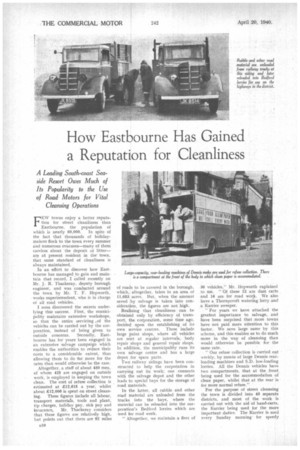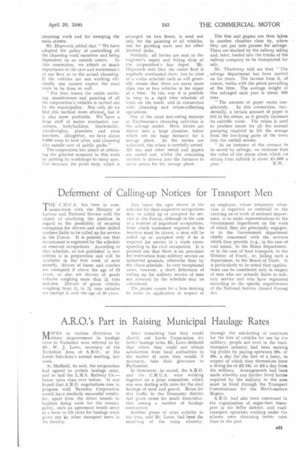How Eastbourne Has Gained a Reputation for Cleanliness
Page 68

Page 69

If you've noticed an error in this article please click here to report it so we can fix it.
A Leading South-coast Seaside Resort Owes Much of Its Popularity to the Use of Road Motors for Vital
Cleansing Operations
FEW towns enjoy a better reputation for street cleanliness than Eastbourne, the population of
which is nearly 60,000. In spite of the fact that thousands of holidaymakers flock to the town every summer and numerous evacuees—many of them careless about the deposit of litter— are at present resident in the town, that same standard of cleanliness is always maintained.
In an effort to discover how Eastbourne has managed to gain and maintain that record, I called recently on Mr. J. R. Thackeray, deputy borough engineer, and was conducted around the town by Mr. T. F. Hepworth, works superintendent, who is in charge of all road vehicles.
I soon discovered the secrets underlying this success. First, the municipality maintains extensive workshops, so that the entire servicing .of the vehicles can be carried out by the corporation, instead of being given to outside concerns. Secondly, Eastbourne has for years been engaged in an extensive salvage campaign which enables the authorities to reduce their costs to a considerable extent, thus allowing them to do -far more for the rates than would otherwise be the case.
Altogether, a staff of about 450 men, of whom 425 are engaged on outside work, is employed in keeping the town clean. The cost of refuse collection is estimated at 212,615 a year, whilst about £12,000 is spent on street cleans ing. These figures include all labour, transport materials, tools and plant, tip charges, holiday pay, sick pay and insurance, Mr. Thackeray considers that these figures are relatively high, but points out that there are 92 miles of roads to be covered in the borough, which, altogether, takes in an area of 11,653 acres. But, when the amount saved by salvage is taken into consideration, the figures are not high.
Realizing that cleanliness can be obtained only by efficiency of transport, the corporation, some time ago, decided upon the establishing of its own service centres. These include large paint shops, where all vehicles are sent at regular intervals, body repair shops and general repair shops. In addition, the municipality runs its own salvage centre and has a large depot for spare parts.
Two railway sidings have been constructed to help the corporation in carrying out its work; one connects with the salvage depot and the other leads to special hays for the storage of road materials.
In the latter, all rubble and other road material are unloaded from the trucks into the bays, where the material can be reloaded into the corporation's Bedford lorries which are used for road work.
" Altogether, we maintain a fleet of 30 vehicles," Mr. Hepworth explained to me. " Of these 12 are dust carts and 16 are for road work. We also have a Thornycroft watering lorry and a Karrier sweeper.
" For years we have attached the greatest importance to salvage, and have been surprised that more towns have not paid more attention to this factor. We save large sums by this scheme, and this enables us to do much more in the way of cleansing than would otherwise be possible for the same rate.
" Our refuse collection is carried out weekly. by means of large Dennis rearloading machines and S.D. low-loading lorries. All the Dennis vehicles have two compartments, that at the front being used for the accommodation of clean paper, whilst that at the rear is for more normal refuse."
For the purpose of street cleansing the town is divided into 48 separate districts, and most of the work is carried out with the aid of hand-carts, the Karrier being used for the more important duties. The Karrier is used every Sunday morning for speedy
cleansing work and for sweeping the main streets.
Mr. Hepworth added that " We have adopted the policy of controlling all the cleansing work ourselves and being dependent on no outside source. In this connection, we attach as much importance to the care and maintenance of our fleet as to the actual cleansing. If the vehicles are not working efficiently one cannot expect the road work to be done so well.
" For that reason the entire servicing, maintenance and painting of all the corporation's vehicles is carried out by the municipality. Not only do we find this method more efficient, but it is also more profitable. We have a large staff of motor mechanics, carpenters, bodybuilders, blacksmiths, wheelwrights, plumbers and even foresters, Altogether, we have about 0,000 trees to look after, and cleansing also entails care of public parks."
The corporation has aimed at obtaining the greatest economy in this work by putting its workshops to many uses. For instance, the paint shop, which is arranged on two floors, is used not only for the painting of all vehicles, but for painting seats and for other kindred tasks.
Similarly, all lorries are sent to the engineer's repair and fitting shop at the corporation's bus depot. Mr. Hepworth said that the entire fleet is regularly overhauled there, but he aims at a works schedule such as will generally ensure that there are never more than one or two vehicles in for repair at a time. In this way it is possible to keep to a rigid time schedule of work on the roads, and in connection with cleansing and refuse-collecting operations.
One of the most interesting features of Eastbourne's cleansing activities is the salvage centre. Here, lorries are driven into a large chamber, below which are six huge furnaces for a sew-age plant. As the lorries are unloaded, the refuse is carefully sorted. All tins and other metal and papers arc sorted out, whilst the remaining rubbish is thrown into the furnaces to make steam for the sewage plant. The tins and papers are then taken to another chamber close by, where they are put into presses for salvage. These are stacked by the railway siding and, later, loaded into the trucks of the railway company to be transported for sale.
Mr. Thackeray told me that " The salvage department has been carried on for years. The income from it, of course, varies with the prices prevailing at the time. The average weight of tins salvaged each year is about 950 " The amount of paper varies con
siderably. In this connection, incidentally, a certain amount of paper is left in the refuse, as it greatly increases its calorific value. The refuse is used to produce steam for all the normal pumping required to lift the sewage from the low-lying parts of the town into the outfall sewers.
" As an instance of the amount to be saved by salvage, we estimate that the value of the steam atone which we obtain from rubbish is about £1,000 a year.'' N.W.




































































































